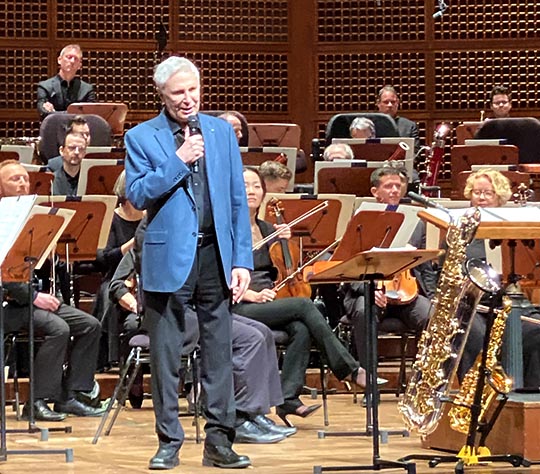Last week the San Francisco Symphony offered the world premiere of a saxophone concerto by the famous 84-year-old American composer John Corigliano. The composer gave a charming introduction to the work from the stage, explaining that the piece was called Triathalon, Concerto for Saxophonist and Orchestra because each of the three movements used a different kind of instrument. The first movement, Leaps, featured a soprano saxophone; the middle movement, Lines, an alto saxophone; and the final Licks movement a baritone saxophone, with a hasty, circular return to the soprano sax at the end.
I have never warmed up to any of Corigliano's music over the decades, from his The Ghosts of Versailles opera to his AIDS-reflective Symphony #1 to his film soundtracks for Altered States and The Red Violin. Joshua Kosman in the SF Chronicle wrote a rave review of the new concerto (click here), so I was hoping this might be a conversion moment, but it was not. The soloist for whom it was written, Tim McAllister, was as virtuosic and entertaining as could be, but the music sounded banal and the integration between soloist and orchestra under debuting guest conductor Giancarlo Guerrero felt lacking, with the orchestra often just imitating the Leaps of the soprano sax, meandering during the melodic Lines, and motoring along for the timid Licks of the finale.
Still, it is always exciting to hear the San Francisco Symphony in new music, where they excel, and it was a joy seeing Wyatt Underhill in the Concertmaster's chair bumping elbows with Tim McAllister at the end of the performance.
Guest conductor Giancarlo Guerrero, originally from Central America, is the Music Director of the Nashville Symphony, and he brought along works that had never been performed here before. The other three pieces were all musical depictions of places: Adolphus Hailstork's 1985 An American Port of Call about Norfolk, Virginia; Antonio Estevez's 1942 Mediodia en el Lanno about the grassy prairies in central Venezuela; and finally Astor Piazzolla's 1952 Sinfonia Buenos Aires. Hailstork's depiction of Norfolk sounded like one fanfare after another without much evocation of water or boats and Guerrero played it too emphatically loud. The same was true for Piazzola's one attempt at a major symphonic work before he settled into his genius melding of classical music language and tango orchestra. The only work that was quieter and sheerly enjoyable was Estevez's 10-minute evocation of Venezuela's highlands.





No comments:
Post a Comment